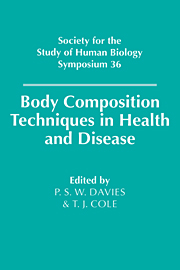Book contents
- Frontmatter
- Contents
- List of contributors
- 1 Application of dual-energy X-ray absorptiometry and related techniques to the assessment of bone and body composition
- 2 In vivo neutron activation analysis: past, present and future
- 3 Magnetic resonance imaging for the assessment of body composition
- 4 Multi-frequency impedance as a measure of body water compartments
- 5 Body composition assessed by electrical conductivity methods
- 6 Body composition in malnutrition
- 7 Influence of body composition on protein and energy requirements: some new insights
- 8 Prediction of adult body composition from infant and child measurements
- 9 Assessment of body composition in the obese
- 10 The role of body physique assessment in sports science
- 11 The assessment of the body composition of populations
- 12 Changes in approach to the measurement of body composition
- 13 Multi-compartment models for the assessment of body composition in health and disease
- 14 The future of body composition research
- Index
12 - Changes in approach to the measurement of body composition
Published online by Cambridge University Press: 18 September 2009
- Frontmatter
- Contents
- List of contributors
- 1 Application of dual-energy X-ray absorptiometry and related techniques to the assessment of bone and body composition
- 2 In vivo neutron activation analysis: past, present and future
- 3 Magnetic resonance imaging for the assessment of body composition
- 4 Multi-frequency impedance as a measure of body water compartments
- 5 Body composition assessed by electrical conductivity methods
- 6 Body composition in malnutrition
- 7 Influence of body composition on protein and energy requirements: some new insights
- 8 Prediction of adult body composition from infant and child measurements
- 9 Assessment of body composition in the obese
- 10 The role of body physique assessment in sports science
- 11 The assessment of the body composition of populations
- 12 Changes in approach to the measurement of body composition
- 13 Multi-compartment models for the assessment of body composition in health and disease
- 14 The future of body composition research
- Index
Summary
Several decades of research in the field of body composition have highlighted a number of new aspects to the subject. The differentiation of body compartments has also become more specific through the development of new methods.
Historical overview
Behnke (1942) examined healthy young men using a two-compartment model which divided the human body into lean body mass and fat mass. He was attempting to characterise young males for élite service in the Marines who had a high body mass index (BMI) but who were at the same time lean and fit American football players. Under such conditions the two-compartment model seemed to be satisfactory, as it assumed that the composition and density of lean body mass and fat were normal and stable. Later measurements have shown that this is not always true – for example in our laboratory we found in some athletes, such as ectomorphic long distance runners or champion hockey players, that total body density was higher than 1.1, which implies differences in the density of lean body mass in these athletes (Parizkova, 1977).
In 1953, Keys & Brozek showed the need to measure the volume of extra-cellular fluid (ECF) in addition to the usual body composition compartments, especially in malnourished subjects, in whom body hydration is disturbed. Subsequently Moore et al. (1963) emphasised that body composition research involves the study of biochemical phases, i.e. the fluids and solids that constitute the human body. They used an isotope dilution approach to differentiate the human body into multiple compartments (Table 12.1). Changes in body composition due to various clinical conditions including chronic wasting disease, acute injury and infection, haemorrhage, heart, renal and hepatic disease and obesity could thus be measured.
- Type
- Chapter
- Information
- Body Composition Techniques in Health and Disease , pp. 222 - 239Publisher: Cambridge University PressPrint publication year: 1995
- 3
- Cited by



